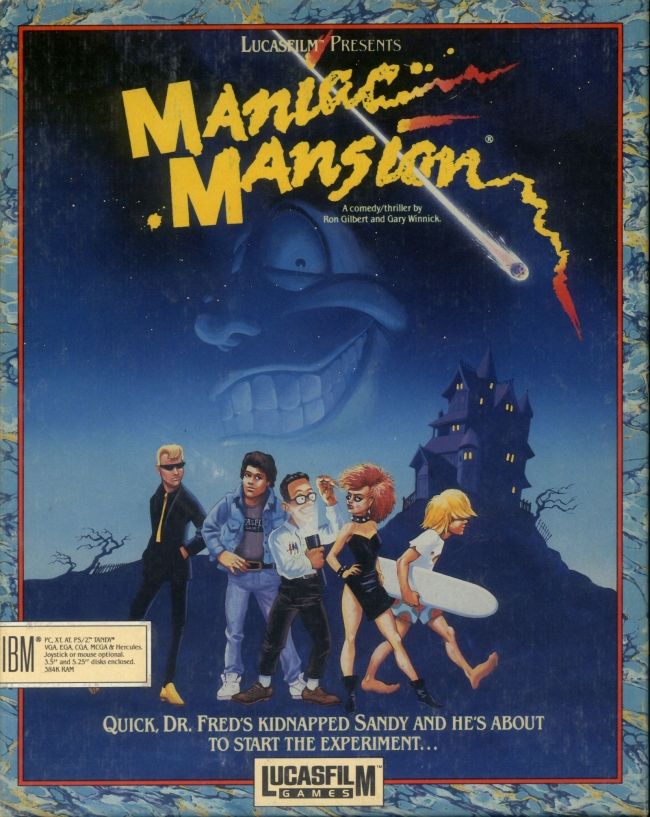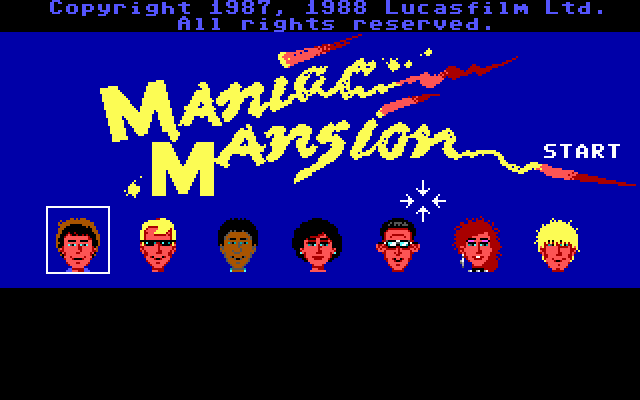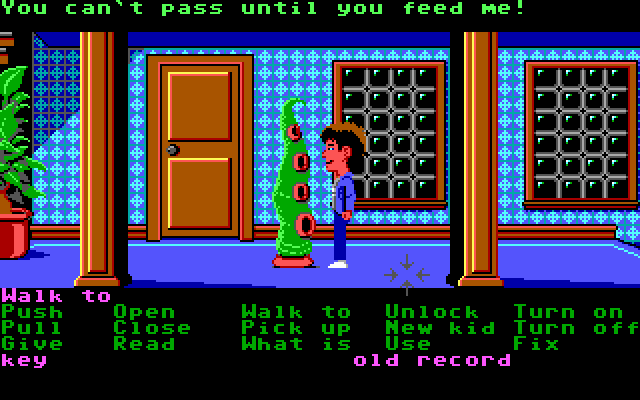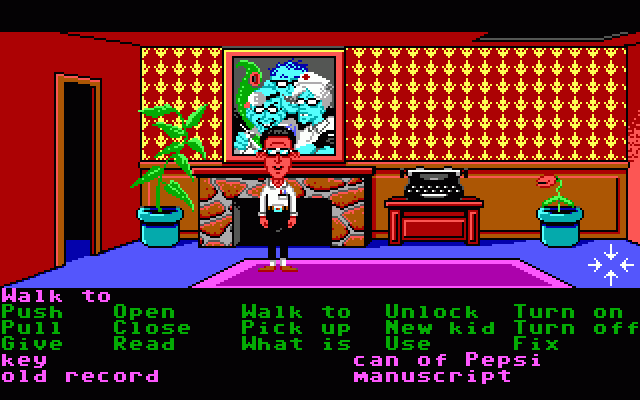Publisher: LucasFilm Games
Designer: Ron Gilbert & Gary Winnick

(“Hey, did anybody see that movie on television last night? These four kids
went into this strange house and... uh, never mind.” -- Michael F. Stoppe)

Enter LucasArts, who in 1987 was going by the name LucasFilm Games. At that time, Sierra and most other producers of adventure games relied on a text parser that referred to a set of specific verbs and nouns (and, very occasionally, adjectives). LucasFilm Games took the adventure game model established by Sierra and upped the ante by introducing, in the form of Maniac Mansion, the world’s first ‘point-and-click’ adventure game: verbs were listed at the bottom of the screen, and a cursor would allow the player to select an object, non-player character, or aspect of the scenery to manipulate.
Maniac Mansion broke new ground stylistically as well. It was highly referential, a kind of bastard offspring of Little Shop of Horrors, Reanimator, Scooby Doo, The Rocky Horror Picture Show and 1980s punk rock; it involved a family of mad scientists, sentient tentacles from outer space, and a handful of distinctly-archetypal teenagers to select from, each one bringing their own abilities to the various puzzles and interactions present in the house of Edison. It was gleefully anarchic, tongue-in-cheek, pointlessly violent and filled with easter eggs and one-off gags. And the whole thing was based on a new interpreter, programmed from the ground up by Gilbert and fellow LucasFilm employee Chip Morningstar, which they called SCUMM - Script Creation Utility For Maniac Mansion - which would later become the cornerstone for all of LucasArts’ graphic adventure games.

Originally released for the Commodore 64, Maniac Mansion was ported to the Amiga, Atari ST, Macintosh and IBM PC... And ultimately, to the Nintendo Entertainment System in 1990. While the NES port was serviceable (and added a few new features, such as individual soundtracks on Discmen for each playable character) it is significant largely because of the amount of pre-Entertainment Software Ratings Board censorship imposed by Nintendo on the conversion project manager, Douglas Crockford, and his team. In a classic tale of missing the forest for the trees, Crockford relates how family-friendly Nintendo demanded the removal or alteration of dozens of objectionable elements, including the words “sucked out” and “kill”, a poster of a sexy mummy, and most of Nurse Edna’s suggestive dialogue, and even took umbrage at the listing of the “NES SCUMM system” in the game’s credits, but completely overlooked the ability for characters to microwave a hamster to death.
The cult of Maniac Mansion has grown steadily since the game was first released. An uncensored Famicom port with redesigned sprites (and, sadly, no translation) was released in 1988. A sequel, Day of the Tentacle, hit shelves in 1993, focusing on Bernard Bernoulli - the nerdy teenager from Maniac Mansion - and his misadventures through time (given the original’s tiny file size, one easter egg present in Day of the Tentacle allows you to access and play through the entirity of Maniac Mansion on an in-game computer). Maniac Mansion Deluxe, a free-to-download remake with updated graphics and audio, was released by LucasFan Games in 2004. German indie developer Vampyre Games is producing a long-in-gestation 3D remake entitled Meteor Mess 3D, while fellow Deutschlanders Edison Interactive are in the process of remaking Maniac Mansion under the name Night of the Meteor, with the goal of adapting the game to a graphical style similar to Day of the Tentacle.

Finally, though it may be daming a classic game with faint praise, Maniac Mansion was one of the first videogames to receive a live-action television adaptation. Lucasfilm and The Family Channel collaborated on the Canadian production, which debuted in 1990 and starred Joe Flaherty, Deborah Theaker, Kathleen Robertson and a disappointingly small number (read: zero) of green or purple tentacles. The show, virtually a spin-off of SCTV with guest spots from Eugene Levy, Dave Thomas, Martin Short and David Cronenberg (!!!), shared almost no similarities with the game other than the name of Flaherty’s protagonist character Dr. Fred Edison and the fact that there was a meteor in the household basement.
| (Maniac Mansion was the first game to include cutscenes. The term ‘cutscene’ was coined by Rob Gilbert to describe the interjected timer-based (rather than behaviour-based) cutaway scenes to non-player characters in the house which propelled the game’s narrative.) |

No comments:
Post a Comment